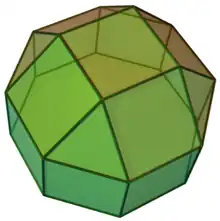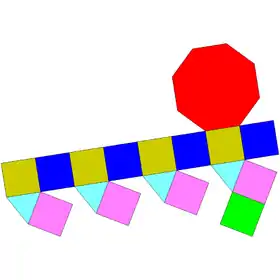Elongated square cupola
In geometry, the elongated square cupola is one of the Johnson solids (J19). As the name suggests, it can be constructed by elongating a square cupola (J4) by attaching an octagonal prism to its base. The solid can be seen as a rhombicuboctahedron with its "lid" (another square cupola) removed.
| Elongated square cupola | |
|---|---|
 | |
| Type | Johnson J18 – J19 – J20 |
| Faces | 4 triangles 3x4+1 squares 1 octagon |
| Edges | 36 |
| Vertices | 20 |
| Vertex configuration | 8(42.8) 4+8(3.43) |
| Symmetry group | C4v |
| Dual polyhedron | - |
| Properties | convex |
| Net | |
 | |
A Johnson solid is one of 92 strictly convex polyhedra that is composed of regular polygon faces but are not uniform polyhedra (that is, they are not Platonic solids, Archimedean solids, prisms, or antiprisms). They were named by Norman Johnson, who first listed these polyhedra in 1966.[1]
Formulae
The following formulae for volume, surface area and circumradius can be used if all faces are regular, with edge length a:[2]
Dual polyhedron
The dual of the elongated square cupola has 20 faces: 8 isosceles triangles, 4 kites, 8 quadrilaterals.
| Dual elongated square cupola | Net of dual |
|---|---|
 |
 |
Related polyhedra and honeycombs
The elongated square cupola forms space-filling honeycombs with tetrahedra and cubes; with cubes and cuboctahedra; and with tetrahedra, elongated square pyramids, and elongated square bipyramids. (The latter two units can be decomposed into cubes and square pyramids.)[3]
References
- Johnson, Norman W. (1966), "Convex polyhedra with regular faces", Canadian Journal of Mathematics, 18: 169–200, doi:10.4153/cjm-1966-021-8, MR 0185507, Zbl 0132.14603.
- Stephen Wolfram, "Elongated square cupola" from Wolfram Alpha. Retrieved July 22, 2010.
- "J19 honeycomb".